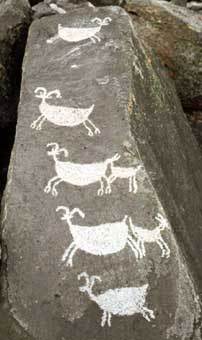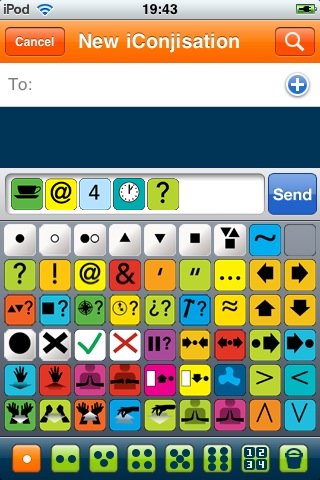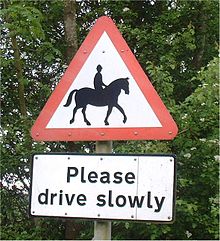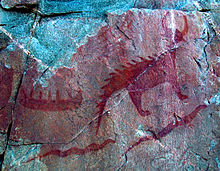An ideogram or ideograph is a graphic symbol that represents an idea or concept, independent of any particular language, and specific words or phrases. Some ideograms are comprehensible only by familiarity with prior convention; others convey their meaning through pictorial resemblance to a physical object, and thus may also be referred to as pictograms.

A logo is a graphic mark, emblem, or symbol used to aid and promote public identification and recognition. It may be of an abstract or figurative design or to include the text of the name that it represents as in a wordmark.

A petroglyph is an image created by removing part of a rock surface by incising, picking, carving, or abrading, as a form of rock art. Outside North America, scholars often use terms such as "carving", "engraving", or other descriptions of the technique to refer to such images. Petroglyphs, estimated to be 20,000 years old are classified as protected monuments and have been added to the tentative list of UNESCO's World Heritage Sites. Petroglyphs are found worldwide, and are often associated with prehistoric peoples. The word comes from the Greek prefix petro-, from πέτρα petra meaning "stone", and γλύφω glýphō meaning "carve", and was originally coined in French as pétroglyphe.

The Dongba, Tomba or Tompa or Mo-so symbols are a system of pictographic glyphs used by the ²dto¹mba of the Naxi people in southern China. In the Naxi language it is called ²ss ³dgyu 'wood records' or ²lv ³dgyu 'stone records'. The first artifacts with this script on them originate from approximately 30 AD.

An emoji is a pictogram, logogram, ideogram, or smiley embedded in text and used in electronic messages and web pages. The primary function of modern emoji is to fill in emotional cues otherwise missing from typed conversation as well as to replace words as part of a logographic system. Emoji exist in various genres, including facial expressions, expressions, activity, food and drinks, celebrations, flags, objects, symbols, places, types of weather, animals and nature.

Miꞌkmaw hieroglyphic writing or Suckerfish script was a writing system for the Miꞌkmaw language, later superseded by various Latin scripts which are currently in use. Mi'kmaw are a Canadian First Nation whose homeland, called Mi'kma'ki, overlaps much of the Maritime provinces, specifically all of Nova Scotia, Prince Edward Island, and parts of New Brunswick and Newfoundland and Labrador.
All Chinese characters are logograms, but can be further categorised based on the manner of their creation or derivation. Some characters may be analysed structurally as compounds created from smaller components, while some are not decomposable in this way. A small number of characters originate as pictographs and ideograms, but the vast majority are what are often called phono-semantic compounds.

A visual language is a system of communication using visual elements. Speech as a means of communication cannot strictly be separated from the whole of human communicative activity which includes the visual and the term 'language' in relation to vision is an extension of its use to describe the perception, comprehension and production of visible signs.

Isotype is a method of showing social, technological, biological, and historical connections in pictorial form. It consists of a set of standardized and abstracted pictorial symbols to represent social-scientific data with specific guidelines on how to combine the identical figures using serial repetition. It was first known as the Vienna Method of Pictorial Statistics, due to its having been developed at the Gesellschafts- und Wirtschaftsmuseum in Wien between 1925 and 1934. The founding director of this museum, Otto Neurath, was the initiator and chief theorist of the Vienna Method. Gerd Arntz was the artist responsible for realising the graphics. The term Isotype was applied to the method around 1935, after its key practitioners were forced to leave Vienna by the rise of Austrian fascism.
The history of communication technologies have evolved in tandem with shifts in political and economic systems, and by extension, systems of power. Communication can range from very subtle processes of exchange to full conversations and mass communication. The history of communication itself can be traced back since the origin of speech circa 100,000 BCE. The use of technology in communication may be considered since the first use of symbols about 30,000 years BCE. Among the symbols used, there are cave paintings, petroglyphs, pictograms and ideograms. Writing was a major innovation, as well as printing technology and, more recently, telecommunications and the Internet.

Mixtec writing originated as a logographic writing system during the Post-Classic period in Mesoamerican history. Records of genealogy, historic events, and myths are found in the pre-Columbian Mixtec codices. The arrival of Europeans in 1520 AD caused changes in form, style, and the function of the Mixtec writings. Today these codices and other Mixtec writings are used as a source of ethnographic, linguistic, and historical information for scholars, and help to preserve the identity of the Mixtec people as migration and globalization introduce new cultural influences.

Coso Rock Art District is a rock art site containing over 100,000 Petroglyphs by Paleo-Indians and/or Native Americans. The district is located near the towns of China Lake and Ridgecrest, California. Big and Little Petroglyph Canyons were declared a National Historic Landmark in 1964. In 2001, they were incorporated into this larger National Historic Landmark District. There are several other distinct canyons in the Coso Rock Art District besides the Big and Little Petroglyph Canyons. Also known as Little Petroglyph Canyon and Sand Tanks, Renegade Canyon is but one of several major canyons in the Coso Range, each hosting thousands of petroglyphs. The majority of the Coso Range images fall into one of six categories: bighorn sheep, entopic images, anthropomorphic or human-like figures, other animals, weapons & tools, and "medicine bag" images. Scholars have proposed a few potential interpretations of this rock art. The most prevalent of these interpretations is that they could have been used for rituals associated with hunting.

Chumash rock art is a genre of paintings on caves, mountains, cliffs, or other living rock surfaces, created by the Chumash people of Southern California. Pictographs and petroglyphs are common through interior California, the rock painting tradition thrived until the 19th century. Chumash rock art is considered to be some of the most elaborate and plentiful rock art tradition in the region.

The Burro Flats site is a painted cave site located near Burro Flats, in the Simi Hills of eastern Ventura County, California, United States. The Chumash-style "main panel" and the surrounding 25-acres were listed on the National Register of Historic Places in 1976, with a boundary decrease in 2020. The main panel includes dozens of pictographs in a variety of colors. The cave is in the mountains, near the bi-lingual Chumash/Fernandeno village of Huwam/Jucjauynga. The Burro Flats painted cave and the rest of the former Santa Susana Field Laboratory are not accessible to the public.

Painted Rock is a smooth horseshoe-shaped marine sandstone rock formation with pictograph rock art about 250 feet across and 45 feet tall near Soda Lake within the Carrizo Plain National Monument on the southwest side of the northern Carrizo Plain, west of Bakersfield and about 70 miles (110 km) east of San Luis Obispo and 45 miles (72 km) west of Taft, in California, United States.

A writing system is a method of visually representing verbal communication based on a script and an orthography or set of rules regulating its use.

iConji is a free pictographic communication system based on an open, visual vocabulary of characters with built-in translations for most major languages.

Rudolf Modley was an Austrian-American research executive, graphic designer, management consultant and author, who founded Pictorial Statistics Inc. in 1934. He illustrated and wrote a series of books on pictorial statistics and pictorial symbolism.
As a common symbol throughout typographic history, the heart shape has found its way into many character sets and encodings, including those of Unicode. Some characters depict the shape directly, others reference it in a more derived manner.






















